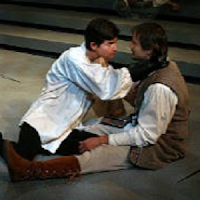Vining believed each subsequent version was a revision of the one previous, each an improvement upon its predecessor on the way to an ultimate, perfect vision of Hamlet which the Stratford man either did not complete or that has been lost to history.
That’s not the unique bit. No, Vining’s grand theory focuses on what he perceived as an increasing “femininity” in the character as these draft progress, as the Dane becomes ever more thoughtful, emotional, and hesitant to act. Soft, if you will.
That Vining's theory is entirely misogynist goes without saying. What is interesting, from a narrative standpoint, is how Vining suggests it was possible that Hamlet was born female, that it was kept a secret, and that she was raised to pass as male. Vining set this all down in his book The Mystery of Hamlet: An Attempt to Solve an Old Problem (1881).
Vining’s theory may have been lost to history, but that it was elevated by Danish film star and producer Asta Nielsen, who used his theory when deciding to play the title role as the premiere offering from her new production company, Art-Film. This 1921 silent film version is quite possibly the best adaptation of Shakespeare’s Hamlet ever made.
 |
| Asta Nielsen in "Hamlet" Art-Film, 1921 |
This is all prologue. The question then is how this all affects her, Hamlet’s, relationships with Ophelia, Horatio, her mother, the new king Claudius, everyone? In 2006, I directed another production of Hamlet at Beck Center for the Arts, inspired by Nielsen’s film, and starring Sarah Morton in the lead, supported by an outstanding company of local artists.
“Since Hansen is experienced and demonstrably astute, there are no embarrassments here and much to appreciate. Most to be appreciated is his shrewd casting of the lady Hamlet. Sarah Morton is a palpably enchanting stage presence – smart, wry, covertly vulnerable and hesitantly self-confident. Properly attired, she's also tall, thin and still tomboyish enough to get away with the physical aspects of the evening's masquerade." - Damico [2]
"Oozing misery and nerves, Morton plays a Hamlet pierced by grief and drunk on death. She handles the language flawlessly, and several of her scenes are the best I've ever seen – her death, and the "nunnery" scene with Ophelia (a sensitive Rachel Lee Kolis)." - Eisenstein [3]
 |
| Hamlet & Horatio Sarah Morton, Nick Koesters Beck Center, 2006 |
“In the final scene, a dying Hamlet places a kiss on Horatio's lips, revealing her true feelings. It's a poignant moment In a credible production of the fiendishly difficult, challenging play, one that keeps the integrity of the language and drama intact.” - Heller [1]
[1] "Review: Hamlet" by Fran Heller, Backstage, 10/16/2006
[2] "Shakespearean Mélange a Trois: A Bardic Orgy of Drag, Gender-bending and Shaky Celibacy" by James Damico, The Free Times, 10/4/2006
[3] "Hamlet @ Beck Center" by Linda Eisenstein, CoolCleveland.com, 10/1/2006

No comments:
Post a Comment